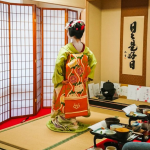
Dinner with Maiko
August 1, 2025| Plan Description | Visitors can experience the tea ceremony in a tea house that has been in existence since the Edo period. ◇History and origin of Wait Seian The Waiting Seian was built about 200 years ago during the Bunka-Bunsei Era (Bunka-Bunsei Era) by Kakugen, the high priest of Horyuji Temple. Kakugen was born in 1764 in what is now Koriyama Jounan, and died at the age of 76, a long life for his time. Kakugen served Horyuji Temple as a priest under the guardianship of Yanagihara Chunagon Takamitsu, and in 1812, he was given the title of high priest by an erection. Kakugen, who was well versed in the tea ceremony, built a tea house called "Taiseian" in the Zenjuin Temple of Horyuji Temple. Horyuji records that he sent out a letter to his fellow monks saying, "The water from the kettle has boiled in the waiting-seian, so I will have a cup of tea," and invited everyone to come and enjoy the tea. In 1870, a monk named Sanjo (real name Higuchi Shosuke), abbot of the Zenjuin temple of Horyuji, retired from his position as abbot and made his home in this area. While living there, he served as the head priest of Horyuji Temple, and wrote many diaries and official documents of Horyuji Temple from the 10th to the 30th of the Meiji period. He moved the tea room of Zenjuin, where he used to live, to the present location of the Kaba residence and enjoyed tea ceremonies there. No details are known as to when or how the tea house was moved. It is possible that the teahouse was dismantled once or that the earthen walls were pulled down without dismantling the teahouse. It was not uncommon at that time to move the teahouse by pulling it down. The oblong long horizontal plaque, "Waiting Seian," was written in 1837 by Zenji Maeyamurozan Tsurufu at the age of ninety-three and engraved by Kakugen when he was seventy-five years old. This oblong plaque is too large for the tea room, so it is possible that it was hung somewhere else. The tea kettle from that time is still kept at Horyuji Temple. |
|---|---|
| Attractions and Course Outline | ◆◆◆Experiencing tea ceremony◇◆◆ You will be taught and experience the following How to bow and greet others, how to serve and drink tea, and how to eat tea cakes Waitseian Waiting Seian was built by Kakugen, the high priest of Horyuji Temple, about 200 years ago at the end of the Edo period (1603-1868) in Zenjyuin, Horyuji Temple. According to the records of Horyuji, Kakugen, who was well versed in the tea ceremony, sent letters to his fellow monks and invited them all to enjoy tea. The tea house also has a Japanese garden, where you can savor tea while viewing the various expressions of the seasons. Please enjoy the Japanese tradition through tea. |
| Schedule Details | Meeting place 2-1-6, Horyuji, Ikaruga-cho, Ikoma-gun, Ikoma 636-0116 (4 minutes walk from Chuguji-mae bus stop of Nara Kotsu, 19 minutes walk from JR Horyuji Station, 10 minutes from Horyuji Interchange on Nishi-Meihan Expressway) Experience time: 14:00-14:30 Please wear socks or tabi socks before going up to the tea ceremony room. ◆◇ Flow of the day◇◇◇◇◇◇ Move to the tea room! ↓arrow (mark or symbol) Start of the experience! ↓arrow (mark or symbol) The tour will end with tea and dismissal. |
| precautions | Please let us know in advance if you have any food allergies. Please wear socks or tabi socks before going up to the tea ceremony room. *In the case of 10 or more people, the experience will be held in a Japanese-style tatami room. |
| What to bring | Please wear socks or tabi (split-toed socks) when going up to the tea ceremony room. |


